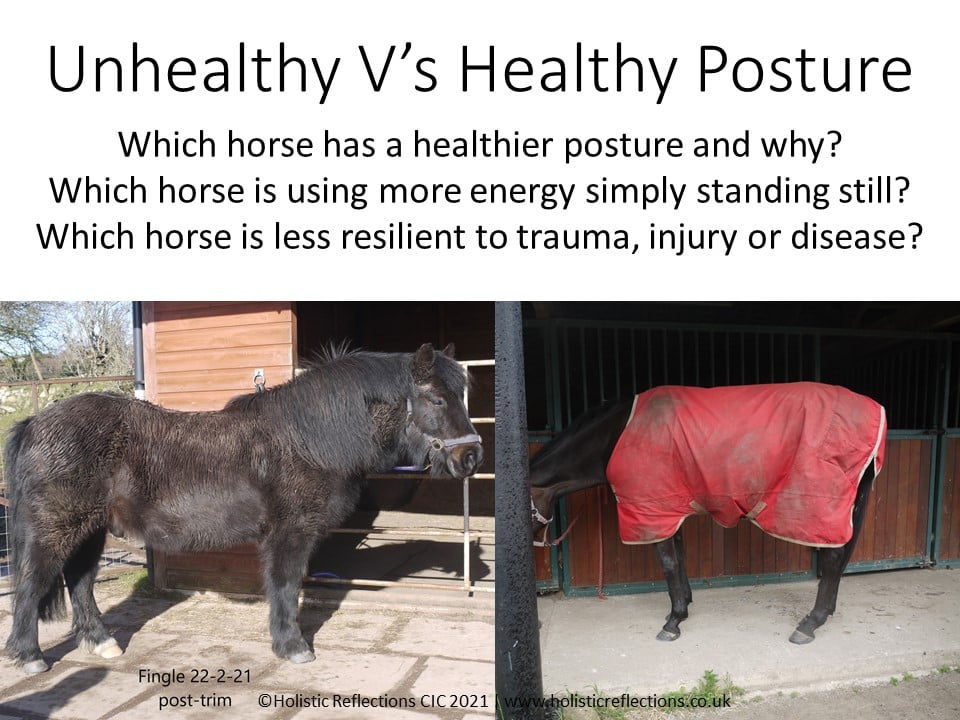No heels, no horse!
- Beccy Smith
- Apr 1, 2021
- 3 min read
The common practice of trimming heels short in order to achieve an idea of "ideal" (healthy ground contact for the frog) contributes to unhealthy compensatory posture which causes tissue to eventually breakdown and results in a plethora of problems for horses (and their owners).
Yes, in a healthy hoof, the frog WILL come into ground contact, however, trimming a hoof to achieve this when it isn't appropriate and where it will inadvertently create more issues is totally avoidable.
Unhealthy posture is also mostly unavoidable and in today's post, we're literally scratching the surface on the topic of ideal hoof morphology and posture and why frogs, heels and posture might be connected...
A fully functioning hoof will be attached to a limb which will be perpendicular to the ground in the relaxed, healthy horse, when standing on a level surface. Anything other than ideal posture requires further investigation as to why the horses proprioception sensors are telling the horse to make other choices, despite this creating problems immediately and further down the line.
There are many reasons for unhealthy posture and the hoof is a major influencer. It both contributes to unhealthy posture and also suffers as a result of unhealthy posture, and it isn't always clear what comes first. If posture improves because of a change in hoof care, then this is both powerful informative and empowering for the horse owner!
We document posture and hooves as part of our diligent documentation and investigations at every consult. We are not the only hoof experts to do so - leading farriers, trimmers ad podiatrists take note of postural changes and are aware of the influence hoof care can have as a way to positively intervene and also as a route to create unhealthy ideals.
Below we feature an aged Shetland pony who had his first proper trim with Beccy and doesn't have ideal hoof morphology but we are able to positively influence the breakover, torque and dorsal/palmar angles to positively influence his posture and gait! If (like common barefoot and farriery trends), we were to lower the heels on these particular hooves so that the frog is in ground contact we would create:
1. low or negative palmar/plantar P3 angles (the back of the pedal bone would be too low in the hoof) creating unhealthy pressure on the tissues in the back of the hoof and under P3, and in the bones, tendons and ligaments in the foot, limb and horse! I 2. Broken back HPA (hoof pastern angle) - putting great strain on the joints, ligaments and tendons of the foot, limb and horse 3. potentially create pressure necrosis, infection and trauma to the frog corium and tissues within the foot including the pedal bone, the deep digital flexor tendon and navicular bursa. 4. The foot would respond by adapting and contracting internally and this would place this pony at real risk of trauma, injury, disease and infection - including laminitis and abscesses. 5. All of the above can create compensatory posture and tissue breakdown as a result of a change of proprioception and deformations which result.
We see MANY horses with low heels (shod and barefoot) and they all improve in their posture, well-being and resilience to trauma, injury, disease and infection as a result of trimming and caring for the hooves and horse in a manner which promotes healthier ideals (heel:toe ratios, palmar/plantar P3 angles, foot height, HPA, and phalangeal:capsular balance around the centre of rotation in ALL anatomical planes.) These ideals will be slightly different according to breed and type but posture ideals remain the same. If the horse is NOT happy standing and resting with all 4 limbs perpendicular to the ground, there might be real cause for concerns - start with assessing hoof balance and proportions...














If, like our clients, you want to learn a PRO-Active approach to hoof care and wish to prevent lameness in your horse, consider booking us for an Integrative Podiatry Consult, Educational Event, On-line Course or join our new VIP membership where you can learn top tips straight from an expert!
We take an integrative and holistic approach to whole horse hoof and body health. We appreciate the relationship between body, limb and hoof and seek to address imbalances while positively influencing appropriate static and dynamic hoof balance and biomechanics.
Beccy Smith BSc DAEP EBW – Independent Equine Podiatrist and CEO of Holistic Reflections CIC
Holistic Reflections CIC – a 100% non-profit organisation promoting wellbeing and resilience in people, horses and the environment - for the benefit of all.









Comments